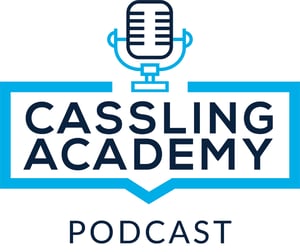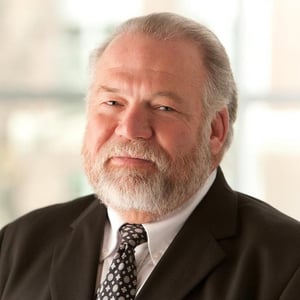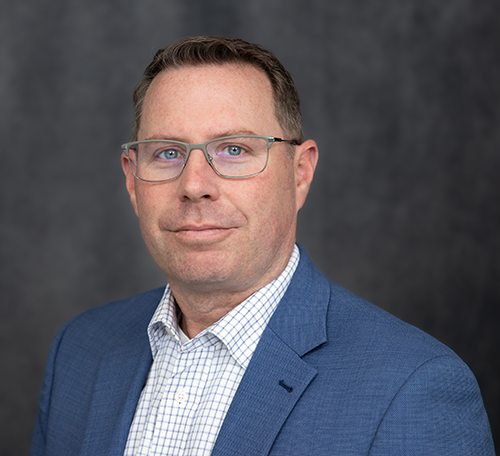Genomics, AI and Healthcare Investment on the Podcast
by Kyle Salem, Ph.D. on Jul 17, 2020
 Cassling President Dr. Kyle Salem sat down with Rodney S. Markin, M.D., Ph.D., Director, UNeTech Institute and Associate Vice Chancellor for Business Development at University of Nebraska Medical Center.
Cassling President Dr. Kyle Salem sat down with Rodney S. Markin, M.D., Ph.D., Director, UNeTech Institute and Associate Vice Chancellor for Business Development at University of Nebraska Medical Center.
In their discussion, Dr. Markin shares his experiences within the healthcare field in the last 30 years and provides insight into how medical imaging, medical treatments and the healthcare field as a whole have changed over the last few decades with the advancements made in technology, medicine, education and resources.
The following is an interview transcript edited for clarity and length. If you prefer, you can listen to the full podcast in the player below.
Kyle Salem: Welcome to the podcast Rodney.
Dr. Markin: Thanks Kyle. Thanks for having me.
Kyle Salem: I could do an intro, but I think it's easier to let you give the audience a sense of your background. Talk about what you're doing now after a couple of decades in the field.
Dr. Markin: I have a couple of hats that I wear. I have been on the faculty as an instructor at the University of Nebraska Medical Center since 1985 with our transplant program. The great part about working at the med center is I've had so many different job opportunities. I started off as a crank-and-grind pathologist and had a lot of development opportunities with the vice chairman of that department. Then I ran the medical practice, it was called University Medical Associates and subsequently UNMC physicians. I was responsible for that for 13 years and learned a lot about how you manage groups of extraordinarily intelligent people, which is not a simple process.
The one thing I learned about healthcare professionals in that process is that, what they really want you to do is listen to them, because they spend almost every day and every night, every holiday, every weekend listening to other people complain about things. This also holds true for physicians, nurse practitioners, PAs and nurses. I've kind of made a 13-year sub career out of listening to people and trying to help them resolve their issues.
I'm responsible for the Behavioral Health Education Center of Nebraska to try to improve the numbers of folks that go into behavioral health, psychiatrists and nurse practitioners and so forth. There's a definite shortage. I'm also a Vice President in a hospital system, Nebraska Medicine, and have some responsibility for network development, and to increase the number of patients and increase our reach across Nebraska.
Kyle Salem: Wow. Lots of hats.
Dr. Markin: Yeah. Plenty of hats. I've never been bored since I set foot on campus. I've had a great time.
Genomics and AI Transform Care Delivery
 Kyle Salem: Let's talk about what's going on in healthcare. Are there themes you're seeing where certain types of businesses are needed or at least being successful from an incubation standpoint?
Kyle Salem: Let's talk about what's going on in healthcare. Are there themes you're seeing where certain types of businesses are needed or at least being successful from an incubation standpoint?
Rodney Markin: One big trend is the genetic evaluation of tumors and other diseases. Ten years ago, I would look at 10 colon cancers and I would think they all look the same, but it turns out that they're 10 different diseases. And in retrospect, this all makes perfect sense because everybody's had a relative that has had cancer, and some of those relatives who had cancer got sick and died very rapidly.
I have a really close friend who was functionally the older sister I never had. She got diagnosed in the summer of 2008 with stage three C breast cancer. My son's mother-in-law got diagnosed on 9/11 with the same type of cancer and is still alive almost 20 years later, but my friend lasted about 19 months. In retrospect, if we would've been doing the genetics, we probably would have found out that those were genetically two different tumors, but we treated them the same. Now, we can drive treatment based upon genetic factors.
Kyle Salem: So this whole genomic space of really understanding—at a micro level—what do they each individually look like?
Rodney Markin: Right now, we have targeted solutions like Keytruda as an example, and there's many of those. And so you either have the genetic trait or genetic defect that says Keytruda is your drug or everybody else gets treated in a big bucket. Until we find more subdivisions of that big bucket, we won't find more targeted treatments. Eventually we may find five or 10 or 15 targeted treatments, which has really changed the outcome for patients.
To expand on that, there's all kinds of different monitoring technology that's out there on the market. I think that's another key area if we can decipher the data because that's the hard part. If we can decipher the data, then it's probably going to give great value to treatment.
Kyle Salem: I think one of the aspects that we're all running across now is we have all of this healthcare data. EMRs have done a great job of amassing data, but they haven't done such a great job of helping us figure out what to do with it. If we can find ways to have computers mine that data and really come up with meaningful steps to follow after that, I think we really have an opportunity there.
Rodney Markin: I agree. I think the AI, machine vision technology is wide open, and I know there are several companies working on applications in the pathology field. And, interestingly enough, I got a call from a gentleman from Israel that I had met about five years ago who happened to be a shot putter at University of Nebraska in Lincoln. He was recruited out of Israel to come and do the shot put for Nebraska and I met him. He called me up and said, "I want to talk to you about this because we've developed an AI solution for prostate cancer detection and biopsies.”
And it turns out that it's actually a pretty interesting application! The part that's unique about prostate biopsies is that they're all done with basically the same needles, they're all long cores of tissue, so you can line them up and orient them and you can eliminate a lot of variables in the equation. They've developed a piece of software that's about 99% accurate compared to people for diagnosing prostate cancer. Given the fact that we have a physician shortage and an overall provider shortage, plus a huge nursing shortage in North America, this actually makes it a lot easier if you can use a tool like that.
Three Keys to Healthcare Investment
Kyle Salem: When you think about investing in the healthcare space, what are the characteristics you look for in an organization?
Rodney Markin: We have a multi-tiered approach to looking at this. We really first look at the technology in the market and whether or not the management team has any experience. Our first three checkboxes are:
- Is it a novel idea? We'd like to see it be patentable. Although, as much as a patent is great, if you don't have the money to defend it, it's not worth anything.
- Is there a huge market for this? Is it a billion-dollar market? Not assuming that you're going to get the billion dollars, but if you get 10% of a billion-dollar market, you have a going concern.
- Are the people who are starting the company, given where the product might be, do they have the skill set to actually get it done? If there's no product or it's a prototype, then the horse you're really betting on is the management team.
This company that we just sold this week, most of the technology came from the University of Michigan. The worthy investment was the group of people who had turned products out several times. They understand the market and how to package it and make it into a product and sell it for more than it costs us to make it, which is another nonacademic concept. Margin and profit. You’ve got to have them.
Kyle Salem: If market is an important thing, what are those forces you see in healthcare today that are shaping what the markets of tomorrow will be? What are the mega healthcare trends that you pay attention to?
 Rodney Markin: In healthcare, we never worried too much about the cost-accounting aspects. Now, that's a broad-brush stroke. Let's say it applies to 75 or 80% of what's out there, but people never kept track of the detail. You keep track of the detail when it comes to patient care or finance. Cost accounting, budgeting and being able to adjust a budget in rapid fashion. As opposed to what we typically do in healthcare is, we set the budget for a year and the budget can't vary, which is fascinating to me because everything else in our life varies!
Rodney Markin: In healthcare, we never worried too much about the cost-accounting aspects. Now, that's a broad-brush stroke. Let's say it applies to 75 or 80% of what's out there, but people never kept track of the detail. You keep track of the detail when it comes to patient care or finance. Cost accounting, budgeting and being able to adjust a budget in rapid fashion. As opposed to what we typically do in healthcare is, we set the budget for a year and the budget can't vary, which is fascinating to me because everything else in our life varies!
Who predicted the coronavirus? Nobody predicted the coronavirus! So there are all these things that happen that you don't have a handle on. Software that allows a budget variance to occur and you can correct or adjust for that, that kind of software's becoming really, really important.
Vision of Healthcare in a Decade: Obesity, Robots, and Alternative Providers
Kyle Salem: I think seeing some of those trends even for the listeners, it's not necessarily about finding them where the market is today. It's a little bit back to the Wayne Gretzky statement, it's not skating to where the puck is, it's skating to where the puck will be that you kind of have to do in this business from an innovation standpoint.
Describe what you see as the healthcare of a decade from now and, importantly, what's different from today?
Rodney Markin: In my opinion, there's more education and availability of information, better drugs, and the shift of all the things we did in the inpatient environment to the outpatient environment. I think we're going to see more and more shift to outpatient surgery. We're going to see sicker and sicker people in the hospital.
But our number one problem is obesity. Of course, you can't get elected by going out and saying, our number one problem is obesity. So people go out and say, our number one problem is the health system is broke or did this or that. But the reality is our number one problem is obesity.
Our ability to try to change the mass of our universe so to speak is something that’s going to be the next big frontier. How we do it, I'm not exactly sure. But if we don't do it, we won't be able to afford it.
Kyle Salem: The transition from inpatient to outpatient, more and more things being done in outpatient, would tend to dictate smaller hospitals with more flexible space to be routed to the things that we need–whether that be more primary care, more outpatient services, more imaging, etc. But then I think we also look at some of those mega trends of the aging baby boomers. Just the sheer number of procedures may dictate that we can't make hospitals a whole lot smaller anytime soon.
Rodney Markin: Well, with the aging population and the way the technology is evolved, there are a lot of next-category things coming in surgical technology. We've had a long-term project in Nebraska Medicine around robotic surgical technology and developing some of the technology on campus which has been spun out into a startup company run out of Santa Clara, California called Virtual Incision. They have intraabdominal robotic devices they can use to do all kinds of different procedures. It’s different than the current surgical robot that everybody has, which is called the da Vinci robot. This is a little more specialized application. The da Vinci is kind of a utility robot and these new robots that are being developed are really specific-use robots. I think we’re going to see a lot of that happening.
Kyle Salem: I don’t think there’s any physician out there that needs to worry about their role going away because we still need the human involved in assembling the information, but it’s about making them all more efficient and practicing more top of license as we go forward.
Rodney Markin: Absolutely. There’s still a projection out there that we’re going to be short 150,000-plus physicians in the next five years. There have been some new medical schools start up, but when they start up, there are 60, 80, 100 kids in a medical school class, which means you're going to crank out 60, 80, 100 physicians and it doesn't make a big dent given the number of folks that are retiring on an annual basis.
Kyle Salem: I don't think anybody's going to start that many medical schools that are new.
Rodney Markin: No. But, if you go to other countries and look at other countries, which everybody's delivery system is a little bit different, we'll pick on China for a minute. China has folks they call barefoot doctors who are really army medics. They work for the government and they're stationed all around and they're your first line of defense. It may not be popular, but we ought to think about other ways to deliver this care. I mean, there are hands-on requirements, so telehealth is not going to solve everything.
Kyle Salem: I think the growth in the alternative provider, whether that be a PA or a nurse practitioner, those mid-levels are certainly a step in that direction. I think until we really get a change in public opinion around what's required and what's needed for care, it'll be hard for us to get there.
Rodney Markin: One of the things that I've suggested to our dean in the college of pharmacy is we find a way to train pharmacists to do more clinical things because there seem to be a lot more pharmacists deployed in distance sites than physicians or PAs or nurse practitioners. Everyone who goes to pharmacy school is smart, it’s all learned behavior. Then we could train the pharmacist to do quite a few things.
Kyle Salem: That's actually a novel concept. I think it'd be interesting just because of knowing, rural Nebraska, rural Kansas, there's a lot of opportunity to use other healthcare professionals in a real direct caregiving role.
Before we wrap up, anything you think the listeners ought to know about your view on healthcare or even technology and investing?
Rodney Markin: I really appreciate the opportunity to be here. As much as we complain about healthcare, a lot of it's in the political campaigning arena. Healthcare in the United States is fabulous. We do a really good job. We have a really open system and pretty good turnaround time for services and it's not perfect, but it's the best.
Kyle Salem: I couldn't agree more. I think we've done a great job with what we have. Well, I want to thank you again for being here.
Rodney Markin: You bet, thank you.
Kyle Salem: Rodney Markin, you've been a wonderful guest and to our listeners, thank you for tuning in. We look forward to talking with you more next time.
Meet the Author
Kyle Salem, Ph.D.
President of Cassling
Kyle joined Cassling in February 2005 and was named President in 2017. Kyle holds a doctorate in Biomedical Engineering as well as business education through the Kellogg School of Management. Prior to Cassling, he worked with Siemens Healthcare's Magnetic Resonance Imaging division serving as a scientist and manager.
Today, Kyle strengthens community healthcare by working with customers to ensure Cassling's offerings meet their short- and long-term goals, as well as clinical, financial and organizational needs. With a focus on helping customer increase quality and decrease cost, he manages Cassling's corporate strategy, advising the organization on industry direction and trends to help intelligently drive the growth, while exploring new business opportunities.
Click
here to request more information about Cassling's Speakers Bureau or call 800-228-5462 ext. 1117.




Comments